Purchasing a travel experience often comes with a high price tag – so customers need to be very certain before making a booking.
Our own research found that today’s holidaymaker undertakes extensive research, drawing on travel agents, review websites and social media channels for inspiration. What’s more, 41% of consumers say the travel booking experience has become more important to them post-pandemic.
That’s why it’s crucial that once a potential booker reaches your website, they’re met with a flawless customer experience. Anything less and you’ll risk losing your visitors to competitor travel providers.
Luckily, travel marketers have ambitious plans to keep holidaymakers engaged. A report by Travolution found that 84% of travel brands are planning to spend more on personalization in the next three years.
Yet the report also found that key parts of the customer journey – website experience, remarketing, inspiration and post-trip engagement – are not reflecting the promise of personalization.
And where personalization is being used, it tends to be based on demographics, rather than behavioral data.
Keep reading to discover 8 easy steps to get started with behavioral targeting for travel.
Why invest in behavioral targeting?
Behavioral marketing strategies tend to have higher conversion rates than generic or demographic-based campaigns.
That’s because internet users’ behavior, such as their actions and inactions, is a clear indicator for their interests.
Marketers can build a picture of each customers’ preferences using browsing behavior, email clicks, abandoned bookings, frequently visited pages and past purchases. These behavioral patterns can be used to deliver the most valuable content, at the moment when it’s most useful to customers.
Behavioral marketing strategies get bad press because we tend to associate it with unwanted tracking and intrusive adverts that follow us around the web.
But in the context of website and email personalization, successful behavioral targeting can be used to significantly improve the customer experience. Here’s how to get started with behavioral targeting for travel.
1. Work out what data you need
Behavioral and transactional consumer data gives the most accurate picture of a customer’s preferences, habits and place in the buying journey.
Insights can come from:
- Pages browsed
- Abandoned bookings
- Content consumed
- Products and categories viewed
- Search keywords
- Visitor frequency
- Carted holidays
- Booked vacations
There are three channels marketers can mine for insightful customer data to help personalize marketing communications:
Website
It’s crucial to be able to collect a shopper’s web behavior across desktop and mobile devices – even if they haven’t identified themselves by clicking on an email link or logging in. Cookies let you identify the shopper on their current device and tie their browsing and purchasing behavior back to their history once they’ve signed up with an email address.
Mobile apps
Behavioral marketing data from desktop and mobile internet browsing can be supplemented with browsing behavior from your travel app. In turn, data from email and web channels can be used to drive personalized content within the application.
Email channels
Lastly, travel marketers need to tap into email data as consumers’ email addresses have become their digital I.D.
Look at the content a recipient clicks on and the types of emails they engage with, as well as the time of day they open your messages.
It’s valuable to consider what type of device a customer opens their emails on – and whether they go on to make a purchase on the same device, or a different one.
Pulling the data together
When deciding which data to use for personalization, there are three factors to consider:
Data needs to be fresh: No relevant insights can be found in stale, inaccurate data.
Data needs to come from as many customer touchpoints as possible: This is the only way to understand customers and deliver the most relevant content.
Data must be fit-for-purpose: For example, website behavioral data shouldn’t only include a list of URLs. It should be broken down to destinations browsed, and other business-meaningful attributes.
2. Start identifying visitors
When new customers come to your travel website, you can start data collection immediately and you can also start queueing up personalized content right away – based on their location and weather, for example.
If cookies are enabled, you can also start to build a picture of an individual traveler’s preferences to start serving tailored content.
But by far the best way to reach potential customers via behavioral targeting is to capture their email address. This opens up more opportunities to reach holidaymakers with helpful content.
When a new visitor comes to your website, you can present a data capture popover based on their behavior.
For example, you could display a slide-over only after the visitor has viewed three vacations, and personalize the offer to match the destinations they’ve browsed. Here’s an example which triggers when a visitor is about to leave the website:
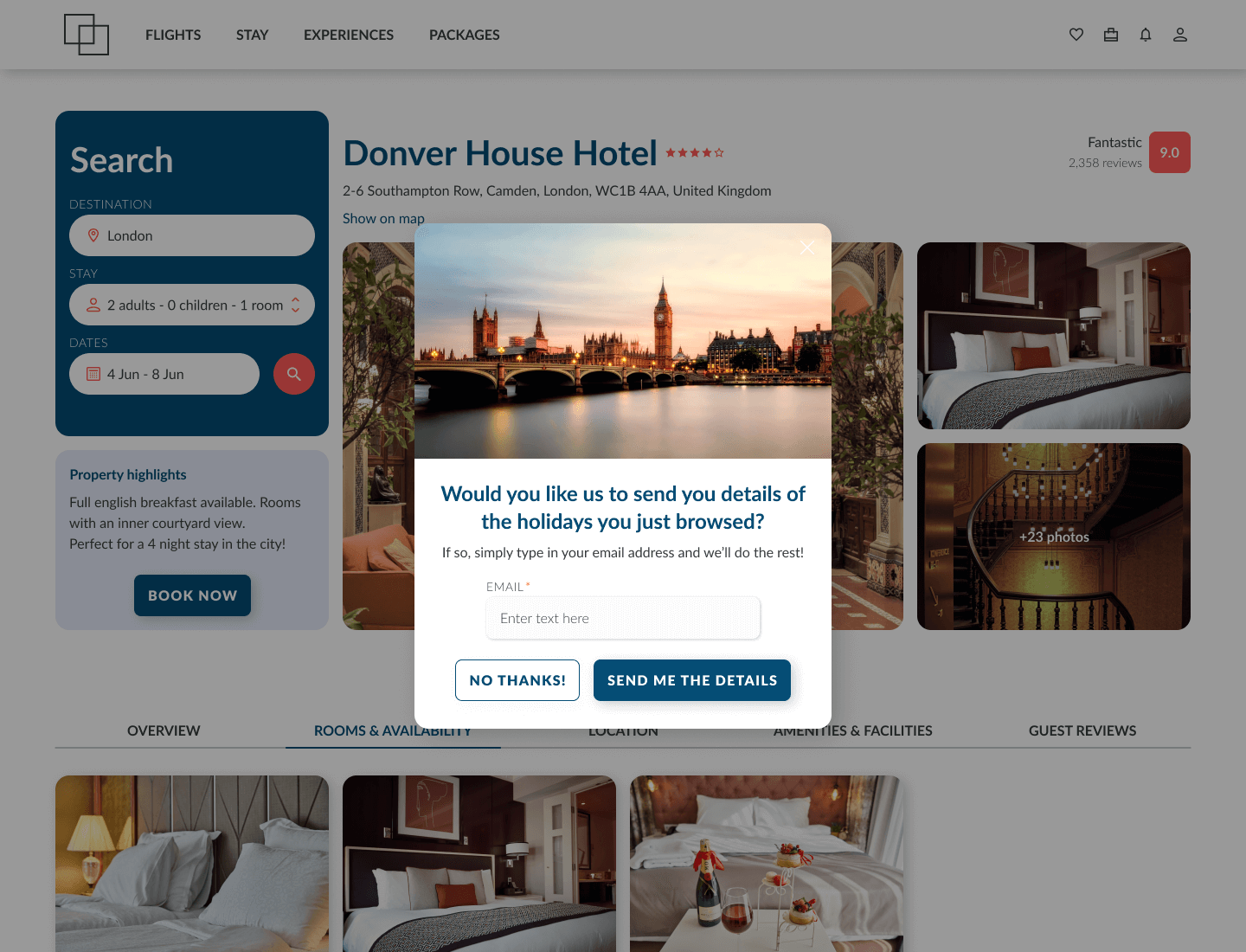
3. Trigger emails based on customer behavior
The simplest way to leverage browse abandonment data is to send triggered booking recovery emails to your target audience looking in the travel market.
Often, your visitors get as far as searching for a date or holiday type, but don’t go on to make a booking.
After these shoppers have left the site, you can send an abandoned booking email automatically populated with their preferences, based on the behavioral marketing data available to you.
Awaze sees a 4% conversion rate across browse abandonment emails for their Cottages.com brand, and the average order value is 16% higher for their cart and browse abandonment emails compared to other marketing emails. Read the full case study.
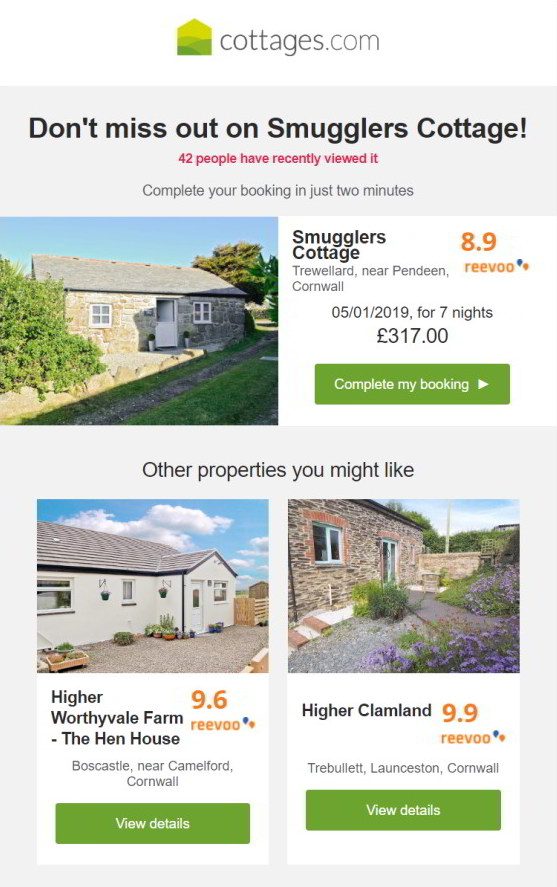
Source: Cottages.com email
A timely email lets shoppers know that the vacation is still available, and reminds them to complete their purchase. Consider including user-generated star ratings to help travelers feel confident in their decision. In addition, you can put personalized product recommendations in this email, to maximize the chances that a consumer books with you.
Other behavioral marketing emails such as price drop alerts can help customers bag a bargain on the holiday they viewed.
4. Work out which behaviors you want to target
Triggering real-time emails based on behavioral targeting is a good start.
But there’s so much more that you can do with behavioral targeting for travel once you have a system in place to collect and coordinate consumer behavior.
These data gathering insights can be used to group customers into behavioral segments (what destinations do they like? Which pages have they viewed recently?) and infer their stage in the customer lifecycle (are they a frequent browser? A new customer?)
Armed with behavioral marketing segments, you’ll be able to deliver relevant information and content that recovers lapsed customers, engages with regular buyers, and monetizes top spenders, based on consumer behaviors.
Behavioral segmentation can be used to send tailored marketing emails, enroll shoppers in relevant triggered email programs, and display customized website content.
First, you’ll need to ask yourself these questions:
- What behaviors do you want to target? Frequent browsing? Carting certain types of vacations?
- Who are the customers that exhibit this behavior? – What are their preferences and motivations? What are their different interests? Where are they in the buying journey and customer lifecycle?
- And what content is most valuable to them right now? – A coupon? A reminder? A recommendation?
5. Target customers with the right content
Behavioral targeting enables personalization by recognizing customers’ context to provide the most appropriate type of content at the right time.
Here are some behavioral marketing examples of audience groups to target:
Frequent bookers
The history of frequent bookers indicates that they’ll probably purchase again. So keep them updated with the latest recommendations, personalized based on their preferences.
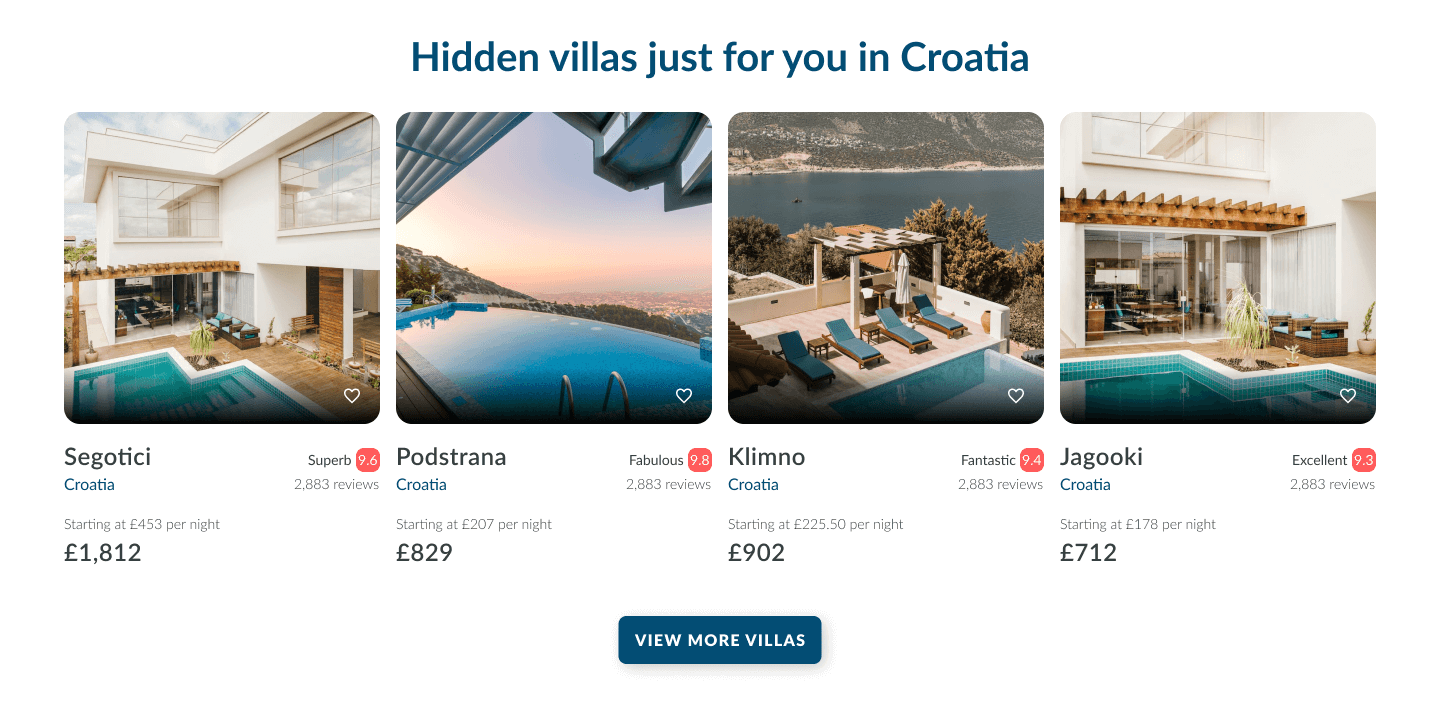
Don’t be tempted to reach out with excessive discounts, as this will diminish the value of a booking that was likely to be placed anyway.
Lapsed customers
These are holidaymakers who’ve booked with you before but haven’t done so in a while. Win back dormant customers by reminding them what they like most about your offerings, based on their past behavior.
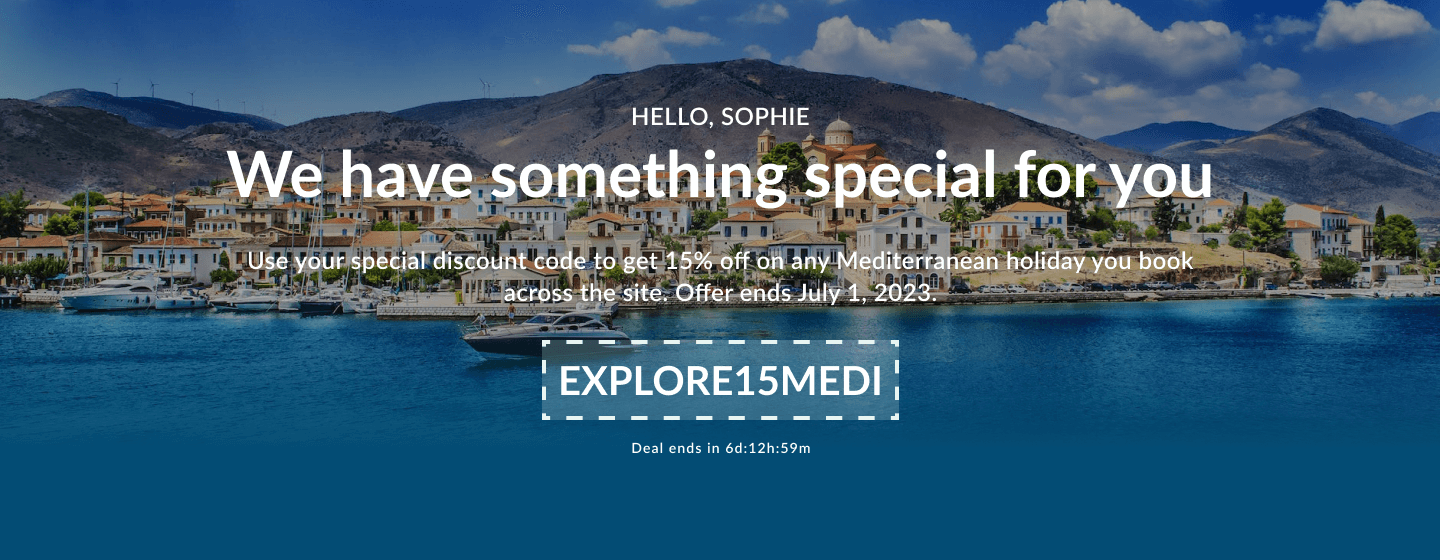
Depending on the nature of the travel brands, customers might naturally wait a while before they book again. A big, no-expense-spared vacation is unlikely to be a frequent purchase. But some travelers might book a weekend city break a few times a year.
Segment shoppers accordingly, and reach out to them when they’re most likely to book again.
In the meantime, you can periodically provide relevant inspiration to give bookers a reason to keep in touch.
High and low spenders
Browse and purchase behavioral data helps pinpoint customers who are tempted by lower-priced deals, and show them packages within their budget.
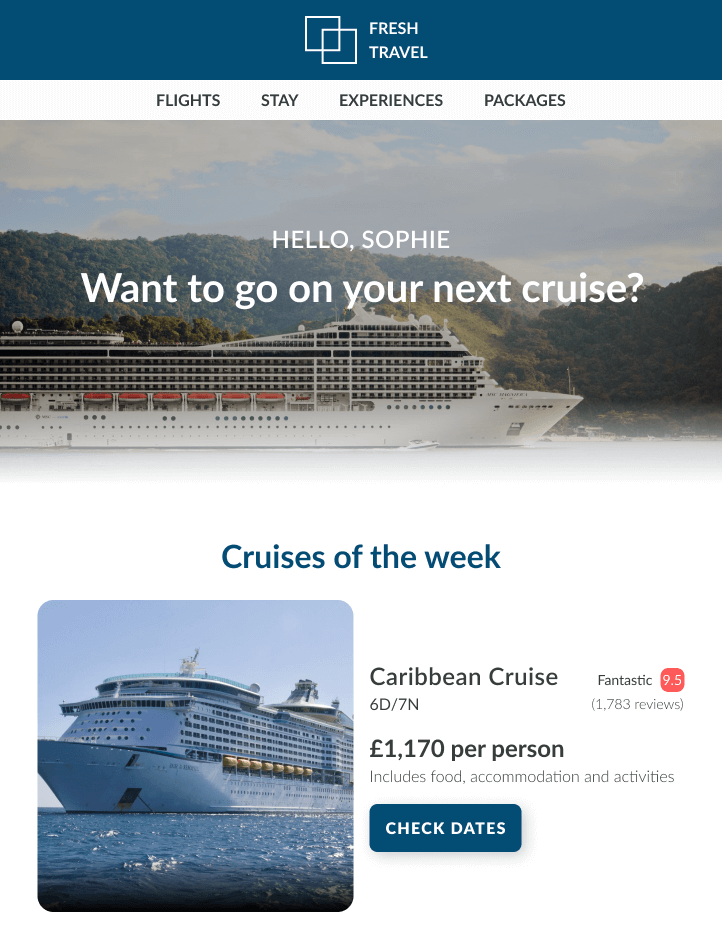
Booking data can also identify customers who tend to spend more than average. Nudge them towards a conversion with banners promoting your higher margin offers for their favorite destinations.
Customers with specific interests
Here’s where segmentation gets really interesting. Behavioral targeting work can be used to build lists of customers who are interested in certain destinations or holiday types. So there’s no reason to send the same generic marketing email or display the same website banner to every customer – instead you can be targeting audiences based on their data.
This is helpful when it comes to ad-hoc promotions to meet one-off marketing objectives. Imagine you’ve been tasked with ensuring a certain package gets booked up. You can create a cross-channel promotion targeting those customers most interested in the given destination. It’s even possible to feed behavioral segments based on website data into your Facebook campaigns.
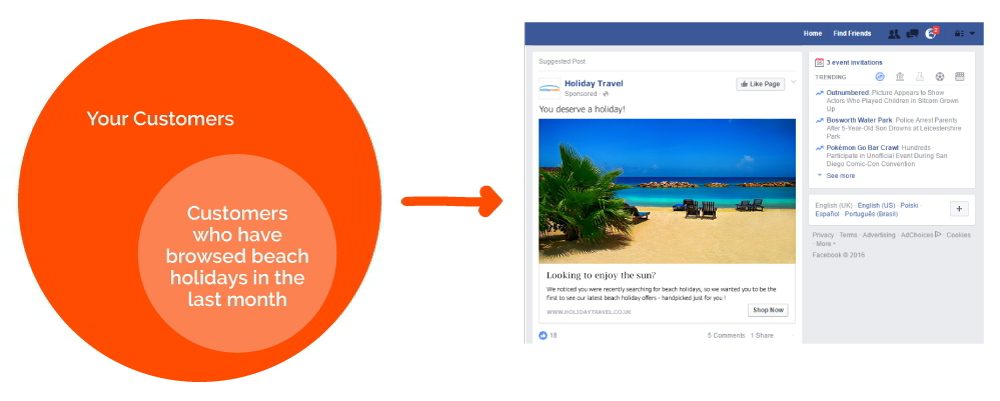
6. Combine with contextual targeting
Effective travel industry marketing strategically combines behavioral and contextual insights to craft the perfect message.
Contextual data comprises all real-time information gathered about customers at the moment they interact with your website or email.
That includes their location, weather, device and the time of the day when they open an email or visit the website.
With behavioral information, you can determine that the visitor will be interested in your latest city breaks. With contextual information, you can tailor the messaging to a customer’s current situation:
“Rain getting you down? Check out these city breaks just for you!”
That’s where dynamic content comes in.
7. Add dynamic, personalized content
Dynamic content lets you personalize communications based on the individual’s interests and context, the moment they visit your website or open an email.

Here are some types of dynamic content to make your offers more compelling:
Personalized banners: A dynamic banner allows you to show each customer the image that’s most likely to spark their interest.
Product recommendations: These can be based on individual behavior, wisdom of the crowd, business priorities, or a combination of all three.
Personalized coupons: Coupons can follow shoppers from emails to the website to maximize exposure and redemption rates.
Personalized countdown timers: Countdown timers can be used across channels to build excitement and let customers know about important dates.
Location and weather-based content: For instance, basing offers on the customer’s nearest airport, or including a real-time weather forecast for the viewed destination.
8. Choosing the right technology
When it comes to behavioral targeting for travel, choosing the right technology is key. Many travel marketers are aware of the data available, but can’t take advantage of it as it sits in inaccessible silos. The good news is that there are easy ways to connect up your data pools, even if you don’t have a big budget for a data integration project. There are data management platforms out there that will travel brands achieve.
In fact, Fresh Relevance has a data management platform that integrates customer data across systems in real time to provide a holistic view of customer behavior. Using intuitive rules and templates, marketers can use this data to engage customers contextually with appropriate messages and offers.
It’s easier than you think to get started with behavioral targeting for travel and serve your travel customers the right content at the right time.






